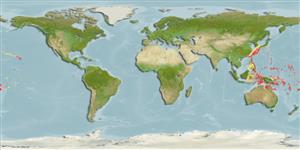Environment: milieu / climate zone / distribuzione batimetrica / distribution range
Ecologia
marino demersale; non migratori; distribuzione batimetrica 80 - 250 m (Ref. 5222). Deep-water; 36°N - 18°S, 117°E - 147°W (Ref. 5222)
Pacific Ocean: southern Japan, Taiwan, Guam, Philippines, South China Sea, Samoa, and Tahiti in French Polynesia. Reported from Fiji and Tuvalu (Ref. 12690).
Size / Peso / Age
Maturità: Lm ? range ? - ? cm
Max length : 43.0 cm TL maschio/sesso non determinato; (Ref. 5222); common length : 25.0 cm TL maschio/sesso non determinato; (Ref. 9137)
Spine dorsali (totale) : 9; Raggi dorsali molli (totale) : 14; Spine anali: 3; Raggi anali molli: 9. Distinguished by having the following characteristics: body depth 2.0-2.4 in SL; body width 2.3-2.6 in depth; caudal peduncle depth equal to or greater than length; head length 2.3-2.5 in SL; dorsal head profile straight or slightly concave to above eye, nape markedly convex; flat interorbital area; rounded preopercle, finely serrate, ventral serrae slightly enlarged, lower edge irregular but hidden by skin; subopercle and interopercle finely serrate; distinctly convex upper edge of operculum; maxilla naked, reaching vertical at rear edge of eye, prominent knob on ventral rear corner; ctenoid body scales, without auxiliaries (Ref. 089707).
Body shape (shape guide): fusiform / normal; Cross section: oval.
A rare species found in deep waters, a specimen was caught at 250 m from Tahiti, French Polynesia. Feeds on fishes and crustaceans (Ref. 089707).
Life cycle and mating behavior
Maturità | Riproduzione | Deposizione | Uova | Fecundity | Larve
Heemstra, P.C. and J.E. Randall, 1993. FAO Species Catalogue. Vol. 16. Groupers of the world (family Serranidae, subfamily Epinephelinae). An annotated and illustrated catalogue of the grouper, rockcod, hind, coral grouper and lyretail species known to date. Rome: FAO. FAO Fish. Synop. 125(16):382 p. (Ref. 5222)
IUCN Red List Status (Ref. 130435: Version 2025-1)
Threat to humans
Harmless
Human uses
Pesca: pesca di sussistenza; Pesce da pesca sportiva: si
Strumenti
Special reports
Download XML
Fonti Internet
Estimates based on models
Preferred temperature (Fonte Biblio.
123201): 18.3 - 26.5, mean 21.3 °C (based on 64 cells).
Phylogenetic diversity index (Fonte Biblio.
82804): PD
50 = 0.5000 [Uniqueness, from 0.5 = low to 2.0 = high].
Bayesian length-weight: a=0.01549 (0.00909 - 0.02638), b=3.02 (2.88 - 3.16), in cm total length, based on LWR estimates for this species & Genus-body shape (Ref.
93245).
Trophic level (Fonte Biblio.
69278): 4.0 ±0.66 se; based on food items.
Resilienza (Fonte Biblio.
120179): Medio, tempo minimo di raddoppiamento della popolazione 1.4 - 4.4 anni (Preliminary K or Fecundity.).
Fishing Vulnerability (Ref.
59153): Low to moderate vulnerability (33 of 100).
🛈
Nutrients (Ref.
124155): Calcium = 36.9 [16.4, 105.4] mg/100g; Iron = 0.481 [0.140, 1.235] mg/100g; Protein = 17.6 [15.7, 19.4] %; Omega3 = 0.453 [0.203, 0.989] g/100g; Selenium = 18.5 [5.3, 51.5] μg/100g; VitaminA = 9.64 [1.94, 49.69] μg/100g; Zinc = 0.311 [0.184, 0.564] mg/100g (wet weight);
